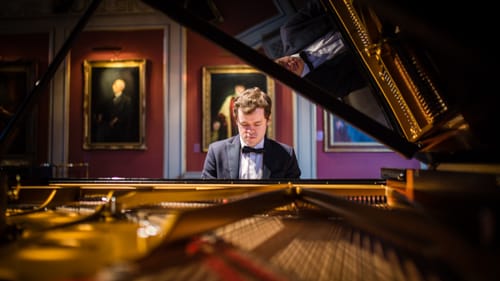Stay in the Loop
BSR publishes on a weekly schedule, with an email newsletter every Wednesday and Thursday morning. There’s no paywall, and subscribing is always free.
Breaking the prophecy
The Philadelphia Orchestra presents Nathalie Stutzmann and Benjamin Grosvenor

The Fourth Symphony and First Piano Concerto are Beethoven’s best works, said no one ever—but great performances can help us discover hidden wonders in these underperformed works, as when Nathalie Stutzmann conducted the Philadelphia Orchestra with pianist Benjamin Grosvenor.
In fact, the Fourth Symphony (which dates to 1806, when the composer was 35) is the least performed of all Beethoven’s symphonies. The First Piano Concerto fares somewhat better, but falls into an earlier period (1795) when Beethoven was just starting to find and refine his unique voice.
Modest expectations seem to guide performances of these works into pallid executions, dooming both of them (particularly the Fourth Symphony) to a self-fulfilling prophecy of adequacy and polite applause.
An enthusiastic Fourth
Fortunately, however, these perceived limitations had no effect whatsoever on the Philadelphia Orchestra this past weekend under the baton of guest conductor Stutzmann, with Grosvenor, a young British pianist, as soloist.
In Stutzmann’s enthusiastic reading, the Fourth is a symphony not of joy or lofty ideals but of earthy good humor. In Beethoven’s lifetime, the key of this work, B-flat major, was associated with happiness and goodwill rather than cries of victory (E-flat major), divine love (A major), and other emotional states (see the full list from 1806, the same year as the Fourth Symphony, in Christian Schubart's Ideen zu einer Aesthetik der Tonkunst).
We won’t find starry heights in this work from the composer’s mature middle period, created as he realized his deafness was irreversible and barreling toward totality. In fact, throughout the entire year of 1806 Beethoven’s brain was like an Instant Pot that someone forgot to depressurize. Blow-ups with the people closest to him (his patron, his brother) occurred throughout the year. It was as though the Fifth Symphony conveyed his profoundest thoughts on destiny, while the Fourth was a conduit for much rowdier, down-to-earth expression.
Foreshadowing the Ninth
In this performance, I thought the opening measures of the first movement were weak and even more subdued than called for in the score, but Stutzmann and some lively bassoonery by Daniel Matsukawa quickly roused the orchestra. The pace seldom lagged in the half-hour that followed. Conducting with a baton throughout the concert, Stutzmann also led with a sunny smile and cheerfulness of demeanor reflected in each musician’s playing. As the positive attitude coursed through the audience, I found myself listening with greater attention. How did I ever miss that rise from a D-flat to a D-natural in the strings (around bar 305), which seemed to be foreshadowing a moment in the Ninth Symphony years in the future?
While even a first-rate performance such as this could not make sense of the second movement for me, the third was a joy, as Stutzmann emphasized with shoulder shrugs and winks the little jokes Beethoven makes throughout. This was even more apparent in the fourth movement, in which Stutzmann achieved a bright staccato response from the orchestra as she alternated between heavy and delicate gestures, relishing every moment.

Haydn’s surprise
The program opened with a lively performance of Haydn’s Symphony No. 94, the “Surprise.” The second movement, with the loud chord so startling to audiences of 1792, sounds a bit trite to us today with our dissonance-acclimated ears, but even this familiar movement is rich with Haydn’s inventiveness, in this case with theme and variations. From start to finish, the symphony was uniformly delightful in the orchestra’s warm, expressive rendering.
It is worth noting that Beethoven was essentially Haydn’s full-time star pupil at the time of the “Surprise” symphony’s premier. And what a surprise it must have been every day to correct the young scamp’s exercises, piano works, and chamber selections, full of startling innovation. This is especially true with the boldly imaginative First Piano Concerto in C major, with its long trills, short-lived but ear-catching discords, and unexpected pauses, effects the composer would employ throughout his life.
A pianist to watch
Benjamin Grosvenor: Now that is a name to watch. The young pianist presented a rich, almost voluptuous version of Beethoven’s First Piano Concerto, delineating themes with clean precision embedded in warm waves of luxurious sound. He evoked such an array of color and variety of tone, signaling some of the earliest stirrings of romantic feeling without betraying the concerto’s classical persona. Stutzmann and the orchestra sensitively responded in conversation to every gambit, creating a seamless musical tapestry.
Whether brushing the keys as in a whisper in the second movement, or opening the third with an assertive solo voice, Grosvenor demonstrated both deep intellectual understanding and soulful art. We can only hope both guest artists will visit us again, and as soon as possible.
What, When, Where
Haydn and Beethoven. Franz Josef Haydn, Symphony No. 94 ("Surprise”); Ludwig van Beethoven, Piano Concerto No. 1 in C major, Op. 15, and Symphony No. 4 in B-flat major, Op. 60. Conducted by Nathalie Stutzmann. Benjamin Grosvenor, piano. The Philadelphia Orchestra. February 28 through March 2, 2019, at the Kimmel Center's Verizon Hall, 300 S. Broad Street, Philadelphia. (215) 893-1999 or philorch.org.
Sign up for our newsletter
All of the week's new articles, all in one place. Sign up for the free weekly BSR newsletters, and don't miss a conversation.

 Linda Holt
Linda Holt